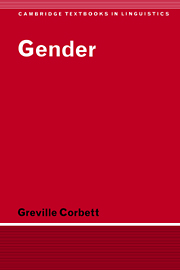Book contents
- Frontmatter
- Contents
- List of figures
- List of tables
- Preface
- List of abbreviations
- 1 INTRODUCTION
- 2 GENDER ASSIGNMENT I: SEMANTIC SYSTEMS
- 3 GENDER ASSIGNMENT II: FORMAL SYSTEMS
- 4 THE PSYCHOLINGUISTIC STATUS OF GENDER ASSIGNMENT
- 5 GENDER AGREEMENT
- 6 ESTABLISHING THE NUMBER OF GENDERS
- 7 TARGET GENDERS: SYNCRETISM AND ENFORCED GENDER FORMS
- 8 HYBRID NOUNS AND THE AGREEMENT HIERARCHY
- 9 GENDER RESOLUTION RULES
- 10 GENERALIZATIONS AND PROSPECTS
- References
- Author index
- Language index
- Subject index
4 - THE PSYCHOLINGUISTIC STATUS OF GENDER ASSIGNMENT
Published online by Cambridge University Press: 05 June 2012
- Frontmatter
- Contents
- List of figures
- List of tables
- Preface
- List of abbreviations
- 1 INTRODUCTION
- 2 GENDER ASSIGNMENT I: SEMANTIC SYSTEMS
- 3 GENDER ASSIGNMENT II: FORMAL SYSTEMS
- 4 THE PSYCHOLINGUISTIC STATUS OF GENDER ASSIGNMENT
- 5 GENDER AGREEMENT
- 6 ESTABLISHING THE NUMBER OF GENDERS
- 7 TARGET GENDERS: SYNCRETISM AND ENFORCED GENDER FORMS
- 8 HYBRID NOUNS AND THE AGREEMENT HIERARCHY
- 9 GENDER RESOLUTION RULES
- 10 GENERALIZATIONS AND PROSPECTS
- References
- Author index
- Language index
- Subject index
Summary
In chapters 2 and 3 we examined data from a wide range of languages and established a typology of gender systems, based on the type of criteria by which nouns are allotted to genders. We also saw that there can be considerable overlaps; a noun may be, say, feminine because of its meaning, morphology and phonology. The question then arises as to which factors are actually used by native speakers. We must therefore ask what is the evidence for the psychological reality of the gender assignment systems discussed. The major evidence is, of course, the data already presented. Given the massive regularities established, and the ease with which native speakers use gender, the most plausible explanation is that speakers assign nouns to genders without difficulty simply by taking advantage of these regularities. We now turn to other facts which help confirm that assignment rules are indeed part of the native speaker's competence and not just regularities observed by linguists. The first type of evidence is provided by borrowings (section 4.1); as new nouns are borrowed into a language they must be given a gender and this allows us to see the assignment rules operating on material which is sometimes unlike that of the native vocabulary. Then we should consider how children acquire gender (section 4.2), as they may learn parts of the system before others and so confirm that there are separate factors at work.
- Type
- Chapter
- Information
- Gender , pp. 70 - 104Publisher: Cambridge University PressPrint publication year: 1991



